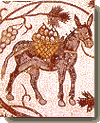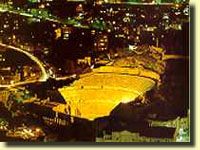 |
AMMAN begin your stay in the capital, Amman, known in
history as Rabbath-Ammon and in Graeco-Roman times as Philadelphia. No more than five
hours drive from anywhere in the country, it is a convenient base for your tour. Business
and the arts are thriving, and there are first-rate hotels, restaurants, galleries and
shops to enjoy. Add to this energetic mix the mystique of old Amman, and all your
expectations will be surpassed. |
| Jerusalem
Every visitor to Palestine must visit the Old City of Jerusalem. Visitors usually have
their own preconceived ideas, religious or political. And yet, each will be surprised by
what they find. For all its fame, Jerusalem is a small town with many faces, weighed down
with history. It offers an enormous amount to see, whether you are interested in ancient
history, religion, or contemporary politics. Within the city, the third holiest site for
Muslims - the Haram al-Sharif from where Mohammed rose to heaven - can be found; the holy
Christian sites of the youth of Jesus, his crucifixion, burial, and resurrection, and the
holiest Jewish site, the Wailing Wall. |
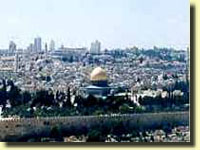 |
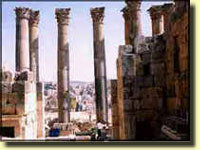 |
Jerash, about one hours drive from Amman. This
"Greco-Roman" city is known as the best preserved and most intact city of the
Decapolis, a confederation of ten roman cities dating from the B.C. Visitors may wonder
through the temple of Artemis, the Theatres, Plazas, Bath and Colonnaded streets, all
enclosed within the city walls of Jerash. Within these walls have been found the remains
of settlements dating from the bronze age. In the month of July, sound and light
performances bring the ancient to life, with its cultural
festival, provdes a stage and meeting place for artists and performers world wide. |
| Umm Qais, among the Decapolis sites is
"Um Qais", known in antiquity as "Gadara", the place where Jesus
performed one of his miracles "The healing of the man with evil spirits", where
the Ottoman Governor's house has been restored and opened as a museum from the Gadara.
Commands a magnificent view over the northern Jordan valley, the sea of Galilee, the
Yarmouk river, and the Golan Heights. |
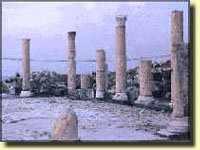 |
Bethany Some 2000 years ago, john the Baptist lived
and baptized in a settlement called “Bethany beyond the Jordan” (John 1:28).
This important site of early Christianity, which Jesus also visited, has now been
rediscovered in Jordan, about (1500 meters) East of Jordan River. It is being carefully
excavated by international archaeologists in preparation for receiving visitors and
pilgrims.
Bethany in the present Kingdome of Jordan (is 45 Kilometers West of Amman), where John the
Baptist lived and baptized, |
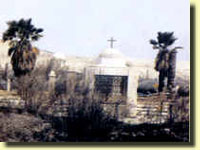 |
has always
Been identified with several ancient prophets and biblical episodes associated with the
Jordan River area.Theses include John the Baptist’s mission, the baptism of Jesus,
Joshua’s crossing of the Jordan River, the last days of Moses, and the Prophets
Elijah and Elisha. This Bethany area has also been known as Bethania and Bethabara as
depicted on the 6th century mosaic map located at the Saint George’s
church in Madaba (35 kilometers from Amman). (from the Arabic Beit el-Obour, or house of
the crossing’), and it called Beit Anya in Arabic language bibles. |
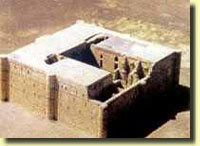 |
Desert castle, The Caliphs of the first dynasty, the Umayyads,
loved the desert and sought to renew themselves in small, lovely palaces in the desert.
Here, the Caliphs would spend their days hawking, hunting and horse racing, followed by
the Turkish Bath in the evening. The best examples of the desert castles are found in the
east of Jordan. |
| MADABA The trip south from Amman along the 5,000-year-old King's
Highway is one of the most memorable journeys in the Holy Land, passing through a string
of ancients sites. The first city you come upon is Madaba, "the City of
Mosaics". Madaba's chief attraction -in the contemporary Greek Orthodox church of St. |
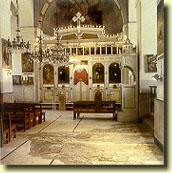 |
George- is a
wonderfully vivid, sixth-century Byzantine mosaic map showing Jerusalem and other holy
sites. Ten minutes to the west is the most revered site in Jordan: Mount Nebo, the
memorial of Moses, the presumed site of the prophet's death and burial place. A small,
square church was built on the spot by early Byzantine Christians, and later expanded into
a vast complex. |
| Mount Nebo, not far away from Madaba, on the top of the hill, a
spectacular view across the Jordan Valley, and the Dead sea. On a clear day the spires of
the churches in Jerusalem are visible in the distance, and at night the lights of the city
are visible too. Mount Nebo is believed to be the tomb of Moses, a lonely, windswept hill,
protecting the ruins of a 4th and 6th century church, whose floor is still covered with
marvelous mosaics. |
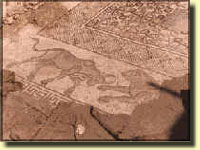 |
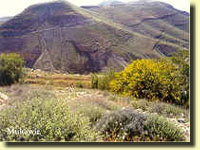 |
Mukawir, about 40 km from Madaba, the ancient Machaerus,
was the fortress built by Herod the great. Here is where Herod imprisoned John the
Baptist, and where the beautiful Salome danced for Herod, who presented her with the head
of John the Baptist to honor her wishes. |
| The Dead Sea At the northern end of the Great Rift Valley lies the
Jordan Valley, the lowest point on the surface of the earth. At the Dead Sea, it is more
than 400 meters below sea level. The valley is typically Mediterranean, with mild winters
and hot summers. The valley also has profound meaning for religious travelers. The Jordan
River is known as the place Jesus was baptized and near where John the Baptist lived. |
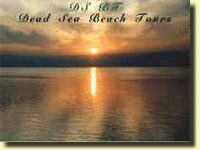
|
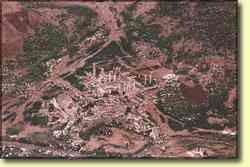 |
Pella, Excavations have revealed at least three
thousand years of human activity at Pella, from the Old Testament days to the medieval
Islamic era. Pella was already an important city in the 19th century B.C and came under
Greek influence in the 3rd and 4th century B.C. The Romans made Pella member of the
Decapolis in the 2nd century A.D. In the 5th and 6th century A.D. it became a Christian
center and stayed important in the times of Islam. In the year 746 B.C. |
| Petra, the rose-red city, 262 km south of Amman.
This Nabatean city is the most famous attraction to Jordan. Dean Burgon, gave Petra the
description which holds to this day: "match me such a marvel save in eastern claim a
Rose-Red city half as old as time". Petra was used as a refuge by nomadic Nabatean
Arabs- Bedouin, who came north, Petra still forms part of the domain of the bedouin. The
visitor finds them waiting with their horses and camels for the unforgettable trip into
the Rose-red City, which comprises a complete urban infrastructure including temples,
baths, private houses, high palaces, paved streets, public buildings, cisterns and
theatres. You reach this marvel through the awesome "Siq" an immense crack in
the nabatean sandstone. It is a winding one km long fissure between overhaning cliffs that
seem to meet more than 300 feet over head. |
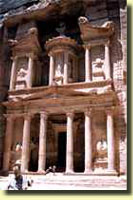 |
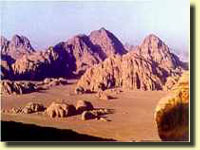 |
Wadi Rum, a place where you feel that the world belongs to you.
"Wadi Rum" is like a moon scape of ancient valleys and towering, weathered
sandstone mountains rising out of the white and pink colored sands. Much of David Leon's
"Lawrence of Arabia" was filmed there and it was also the location where
Lawrence himself was based during the Arab revolt. |
| Red Sea Resort, Aqaba, where fantasy, sun, sea and the atmosphere
of antiquity charm and where the visitors can enjoy themselves, at any time of the year,
in water sports, and winter warmth. Aqaba is warm, sunny and inviting; fringed with palm
trees; lapped by the crystal clear water of the gulf of Aqaba; cooled by a steady
northerly breeze; and, ringed by mountains that change in color with the change of the
hour. |
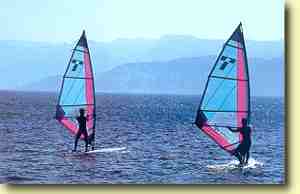 |







